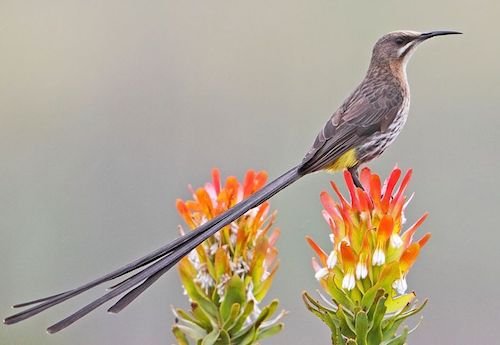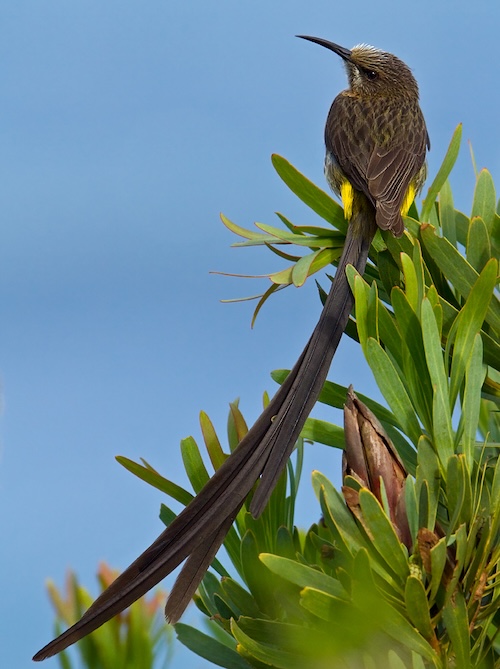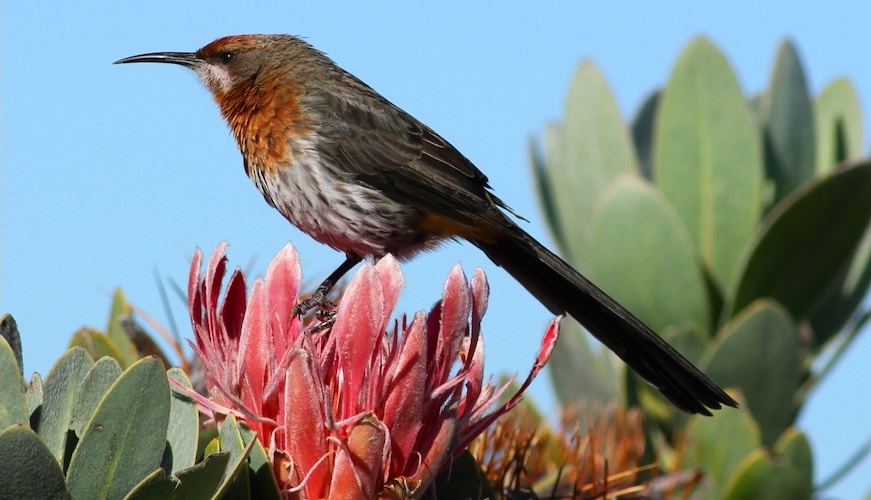Promeropidae – Sugarbirds

The Promeropidae make up a small genus, Promerops, and the family of sugarbirds, which are passerines restricted to southern Africa. The relationships of the sugarbirds have been a source of considerable debate. They were first treated as a far-flung member of the honeyeater family, which is otherwise restricted to the Australasian region. Using egg white proteins in the 1970s, Sibley and Ahlquist mistakenly placed them with the starlings (the samples used were actually those of sunbirds). They have also been linked to the thrushes (Turdidae) and the sunbirds. Molecular studies find support for few close relatives, and currently, they are treated as a monotypic family, although they form a clade with the Modulatricidae, three enigmatic African species formerly placed with the Old-World babblers and thrushes.

Cape Sugarbird Promerops cafer – Dubi Shapiro
In general appearance as well as habits they resemble large long-tailed sunbirds, but are possibly more closely related to the Australian honeyeaters. They have brownish plumage, the long down-curved bill typical of passerine nectar feeders, and long tail feathers.
The Gurney’s Sugarbird is found from Zimbabwe southwards, except the extreme south of South Africa, where it is replaced by the Cape Sugarbird in the Cape provinces of South Africa. It has at times been considered conspecific with Gurney’s. The distribution of the Gurney’s sugarbird is disjunct, and currently there are two accepted subspecies, one in the north and one further south.
Sugarbirds are dependent on Protea and are found in protea scrub. The Cape Sugarbird is found in fynbos and has also moved into gardens and nurseries.
The two sugarbird species are medium-sized passerines that weight between 26g and 46g and are 23cm to 44cm in length. Between to 15cm and 38cm of that length is in their massive elongated tails, with the tails of the Cape Sugarbird being overall longer than those of the Gurney’s Sugarbird. In both species the tail of the male is longer than the female, although the difference is more pronounced in the Cape Sugarbird. In overall body size the males are slightly larger and heavier than the females. Both species have long and slender bills that are slightly curved, and again the females have a slightly shorter bill, leading to differences in feeding niches. The skull and tongue morphology of the sugarbirds is very similar to that of the honeyeaters, the result of convergent evolution. The tongue is long and protrusible, and is tubular and frilled at the end.

Gurney’s Sugarbird Promerops gurneyi – ©Derek Keats CC BY 2.0 via Wikimedia Commons
Nectar from the inflorescences of the Protea provide most of the energy these species require, and they are considered significant pollinators of the genus. The birds’ diet is supplemented by insects attracted to the inflorescences. Studies of the diets of sugarbirds found that bees in the family Apidae and flies formed a large part of the diet and that the insects were obtained by hawking.
The breeding behaviour and nesting habits of the two species of sugarbird are very similar. They are monogamous, and male sugarbirds defend territories during the breeding season. Females lay two eggs in a nest in a fork of a tree.
-
Number of bird species: 2
(As at October 2025)
According to the recently (2025) amalgamated AviList, there are just two species, in one genus in the Promeropidae family. They are:
Cape Sugarbird Promerops cafer
Gurney’s Sugarbird Promerops gurneyi
-
Promeropidae
Family AccountThese slightly shaggy brown and whitish birds may be unremarkable in coloration, but they make up for it with their impressively long streamer-like tails. -
Promeropidae
Family AccountThe sugarbirds are a small genus, Promerops, and family, Promeropidae, of passerine birds, restricted to southern Africa.
Given that this is a tiny family with just two species in only a single genus, Fatbirder provides active links below to both species.
-
Cape Sugarbird Promerops cafer
Species AccountA large nectar-eating bird with a decurved beak and a long graduated tail. Dull brown above, it has strong moustache-like stripes and a yellow undertail. -
Cape Sugarbird Promerops cafer
Species AccountSpecies account… -
Cape Sugarbird Promerops cafer
Species AccountSound archive and distribution map. -
Gurney's Sugarbird Promerops gurneyi
Species AccountA large nectar-eating bird with a decurved beak and a long graduated tail. Dull brown above, it is mostly pale below with a broad rusty breast band and crown. -
Gurney's Sugarbird Promerops gurneyi
Species AccountThe Gurney's sugarbird (Promerops gurneyi) is a species of bird in the Promeropidae family. -
Gurney's Sugarbird Promerops gurneyi
Species AccountSound archive and distribution map.
